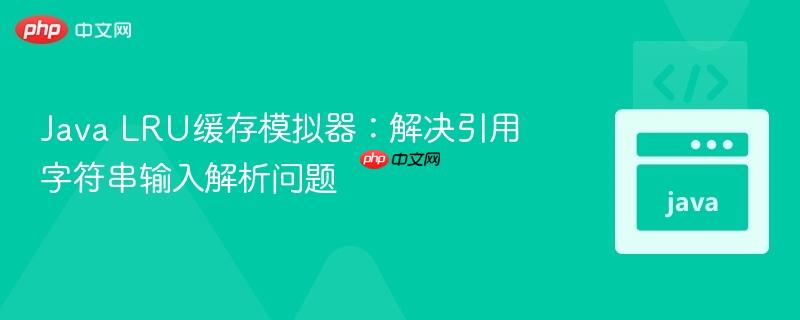
本文旨在解决java lru缓存模拟器中常见的引用字符串输入解析问题。通过分析`scanner`类中`next()`和`nextline()`方法的区别,文章将演示如何正确读取包含空格的引用字符串,并提供优化后的`main`方法代码示例,确保模拟器能够准确处理所有输入数据,从而得出正确的缓存命中率和内容。
在计算机体系结构中,缓存(Cache)是提高内存访问速度的关键组件。为了有效管理有限的缓存空间,需要采用各种替换策略,其中最近最少使用(Least Recently Used, LRU)策略是一种广泛应用且高效的算法。LRU策略的核心思想是:当缓存满时,优先淘汰最近最长时间未被访问的数据块。
实现一个LRU缓存模拟器有助于我们理解和评估不同缓存策略的性能。一个基本的模拟器通常需要接收缓存块数量、关联度、替换策略以及一系列内存访问引用(reference string)作为输入,然后模拟这些访问并输出命中率、未命中率以及最终的缓存内容。
在开发LRU缓存模拟器时,一个常见的问题是,当用户输入包含多个数字(用空格分隔)的引用字符串时,程序可能只读取第一个数字,导致后续的模拟过程出现错误。
考虑以下Java代码片段,它试图读取用户输入的引用字符串:
立即学习“Java免费学习笔记(深入)”;
public static void main(String[] args) {
Scanner in = new Scanner(System.in);
// ... 其他输入 ...
System.out.println("Enter reference string:");
String input = in.next(); // 问题所在
String[] references = input.split(" ");
int[] refs = new int[references.length];
for (int i = 0; i < references.length; i++) {
refs[i] = Integer.parseInt(references[i]);
}
// ... 模拟过程 ...
}当用户输入 3 4 3 5 4 时,如果使用 in.next(),它只会读取第一个非空白字符序列,即 3。next()方法在遇到空白符(如空格、制表符、换行符)时会停止读取。因此,input变量将只包含 3,后续的 split(" ") 操作也只能得到一个元素,导致模拟器无法处理完整的引用序列。
要解决这个问题,我们需要确保程序能够读取用户输入的一整行文本,而不仅仅是第一个词。Scanner类提供了nextLine()方法来完成此任务。
一个常见的陷阱是,当在一个Scanner对象上先调用 nextInt()(或其他 next<Type>() 方法),然后立即调用 nextLine() 时,nextLine() 可能会意外地读取到之前 nextInt() 留下的换行符。这是因为 nextInt() 只读取数字部分,而不会消耗用户按下回车键产生的换行符。这个换行符会留在输入缓冲区中,被随后的 nextLine() 立即读取,导致 nextLine() 得到一个空字符串。
为了避免这个陷阱,有两种主要策略:
int numBlocks = in.nextInt(); in.nextLine(); // 消耗掉nextInt()留下的换行符 String referenceString = in.nextLine();
采用第二个策略,为引用字符串输入创建一个新的 Scanner 对象,可以确保 nextLine() 能够正确读取整行输入,而不会受到之前 nextInt() 调用的影响。
package cacheProject;
import java.util.Scanner;
public class cacheProject {
private int numBlocks;
private int setAssoc;
private String replacementPolicy;
public cacheProject(int numBlocks, int setAssoc, String replacementPolicy) {
this.numBlocks = numBlocks;
this.setAssoc = setAssoc;
this.replacementPolicy = replacementPolicy;
}
// 简化版 simulate 方法,用于演示输入修复后的效果
// 注意:此LRU实现仅为示例,实际生产环境需更完善的LRU逻辑
public void simulate(int[] references) {
int hits = 0;
int misses = 0;
// 假设这里有一个更完善的LRU缓存数据结构,例如使用LinkedHashMap或自定义双向链表
// 为了演示输入解析,我们暂时使用一个简单的数组来表示缓存内容
// 实际LRU需要记录访问时间/顺序
int[] cache = new int[numBlocks];
int[] lruTracker = new int[numBlocks]; // 简单模拟LRU计数器,数值越大表示最近访问
System.out.println("\n--- Cache Simulation ---");
for (int i = 0; i < references.length; i++) {
int currentBlock = references[i];
boolean inCache = false;
int hitIndex = -1;
// 检查是否命中
for (int j = 0; j < cache.length; j++) {
if (cache[j] == currentBlock) {
inCache = true;
hits++;
hitIndex = j;
break;
}
}
if (inCache) {
// 命中:更新LRU状态
System.out.println("Access " + currentBlock + ": Hit");
// 简单更新LRU计数,这里只是一个概念性的更新
for(int k=0; k<cache.length; k++) {
if (k != hitIndex && cache[k] != 0) { // 假设0代表空槽
lruTracker[k]++;
}
}
lruTracker[hitIndex] = 0; // 命中块最近使用,重置计数
} else {
// 未命中:添加新块
misses++;
System.out.println("Access " + currentBlock + ": Miss");
// 查找空槽
int emptySlot = -1;
for (int j = 0; j < cache.length; j++) {
if (cache[j] == 0) { // 假设0表示空槽
emptySlot = j;
break;
}
}
if (emptySlot != -1) {
// 有空槽,直接添加
cache[emptySlot] = currentBlock;
lruTracker[emptySlot] = 0; // 新加入的块最近使用
// 其他块的LRU计数增加
for(int k=0; k<cache.length; k++) {
if (k != emptySlot && cache[k] != 0) {
lruTracker[k]++;
}
}
} else {
// 缓存已满,根据LRU策略替换
int lruBlockIndex = 0;
int maxLruValue = -1; // 寻找LRU计数最大的块
for (int j = 0; j < cache.length; j++) {
if (lruTracker[j] > maxLruValue) {
maxLruValue = lruTracker[j];
lruBlockIndex = j;
}
}
System.out.println("Replacing block " + cache[lruBlockIndex] + " with " + currentBlock);
cache[lruBlockIndex] = currentBlock;
lruTracker[lruBlockIndex] = 0; // 新加入的块最近使用
// 其他块的LRU计数增加
for(int k=0; k<cache.length; k++) {
if (k != lruBlockIndex && cache[k] != 0) {
lruTracker[k]++;
}
}
}
}
System.out.print("Current Cache: ");
for (int val : cache) {
System.out.print(val + " ");
}
System.out.println();
}
System.out.println("\n--- Simulation Results ---");
System.out.println("Total references: " + references.length);
System.out.println("Hits: " + hits);
System.out.println("Misses: " + misses);
System.out.printf("Miss rate: %.2f%%%n", (double) misses / references.length * 100);
System.out.print("Final Cache contents: ");
for (int i = 0; i < cache.length; i++) {
System.out.print(cache[i] + " ");
}
System.out.println();
}
// 原始 findLRUBlock 方法逻辑有误,此处不使用,而是集成到 simulate 中
// public int findLRUBlock(int[] cache) { /* ... */ return -1; }
public static void main(String[] args) {
Scanner in = new Scanner(System.in);
System.out.print("Enter number of cache blocks: ");
int numBlocks = in.nextInt();
System.out.print("Enter set associativity (1=direct mapped, 2=2-way, 4=4-way): ");
int setAssoc = in.nextInt();
System.out.print("Enter replacement policy (FIFO or LRU): ");
String replacementPolicy = in.next();
// 为引用字符串输入创建独立的Scanner对象
Scanner inRef = new Scanner(System.in);
System.out.println("Enter reference string (space separated numbers):");
String input = inRef.nextLine(); // 使用 nextLine() 读取整行
String[] references = input.trim().split(" "); // 使用 trim() 移除首尾空白,split() 分割
int[] refs = new int[references.length];
for (int i = 0; i < references.length; i++) {
refs[i] = Integer.parseInt(references[i]);
}
cacheProject cacheSimulator = new cacheProject(numBlocks, setAssoc, replacementPolicy);
cacheSimulator.simulate(refs);
in.close(); // 关闭Scanner
inRef.close(); // 关闭Scanner
}
}代码改进说明:
使用上述修正后的代码,当输入 3 4 3 5 4 3 5 作为引用字符串时,程序将能够正确解析并模拟整个序列。
示例输出 (使用修正后的 simulate 方法):
Enter number of cache blocks: 5 Enter set associativity (1=direct mapped, 2=2-way, 4=4-way): 1 Enter replacement policy (FIFO or LRU): LRU Enter reference string (space separated numbers): 3 4 3 5 4 3 5 --- Cache Simulation --- Access 3: Miss Current Cache: 3 0 0 0 0 Access 4: Miss Current Cache: 3 4 0 0 0 Access 3: Hit Current Cache: 3 4 0 0 0 Access 5: Miss Current Cache: 3 4 5 0 0 Access 4: Hit Current Cache: 3 4 5 0 0 Access 3: Hit Current Cache: 3 4 5 0 0 Access 5: Hit Current Cache: 3 4 5 0 0 --- Simulation Results --- Total references: 7 Hits: 4 Misses: 3 Miss rate: 42.86% Final Cache contents: 3 4 5 0 0
可以看到,现在所有的引用数字都被正确地读取和处理了。
通过正确处理用户输入,我们的LRU缓存模拟器能够接收并处理完整的引用字符串,为后续精确的缓存性能分析奠定了基础。
以上就是Java LRU缓存模拟器:解决引用字符串输入解析问题的详细内容,更多请关注php中文网其它相关文章!

每个人都需要一台速度更快、更稳定的 PC。随着时间的推移,垃圾文件、旧注册表数据和不必要的后台进程会占用资源并降低性能。幸运的是,许多工具可以让 Windows 保持平稳运行。

Copyright 2014-2025 https://www.php.cn/ All Rights Reserved | php.cn | 湘ICP备2023035733号